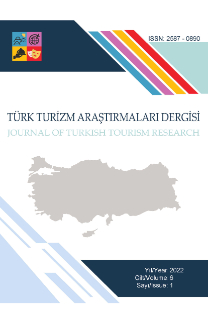Müşterilerin Restoran Tercihine Göre Kümelendirilmesi Üzerine Kayseri’de Bir Araştırma
Dışarıda yemek yeme olgusu giderek yaygınlaşmaktadır. Bu durum nerede ne yeneceği sorusunu gündeme getirmektedir. Araştırmanın amacı, restoran tercihini etkileyen faktörleri belirlemek ve bu faktörlere göre tüketicileri kümelemektir. Veriler; literatüre dayalı geliştirilen bir anketin, Kayseri’de yaş grupları dikkate alınarak kota örneklemesi esasına göre 01 Kasım 2016-31 Ocak 2017 tarihleri arasında yüz yüze uygulanarak toplanmıştır. Kayıp veri, çoklu sapan ve normal dağılım analizleri ve tanımlayıcı istatistiklerin yanı sıra, faktör, kümeleme, t-testi ve ki-kare analizlerinden yararlanılmıştır. Kümeleme sonunda “seçiciler” ve “umursamazlar” şeklinde iki grup oluşmuştur. Kümeler ile cinsiyet, yaş grupları ve eğitim seviyesi arasında anlamlı ilişkiler tespit edilmiştir. Bildiri, restoran yöneticilerinin restoran tercihini etkileyen faktörlere göre oluşan “seçiciler” ile “umursamazlar” gruplarını daha yakından tanıyarak, buna uygun tutundurma faaliyetleri yapmaları önerisi ile son bulmaktadır.
A Study on Clustering Customers Based on Restaurant Preferences: A Case Study in Kayseri
The concept of eating out has gradually become more widespread, which brings about the question of where and what to eat. The aim of the present study is to determine the factors that affect restaurant preferences and to cluster customers in accordance with those preferences. Taking into consideration the age group of the participants and employing quota sampling, the data were gathered through a face-to-face survey, which was developed based on the literature, between the dates of November 1, 2016 and January 31, 2017 in Kayseri. Along with missing data, Mahanobilis distance and normal distribution analysis, descriptive statistics, factor, cluster, t-test and chi square test analysis were employed. Clustering has resulted in two groups, which are “the picky” and “the indifferent”. It has been found out that there is a significant relationship between clusters and gender, age groups and educational level. The study concludes with the suggestion that restaurant managers should be closely acquainted with “the picky” and “the indifferent” groups, which are composed based on the factors that affect restaurant preferences, and that they should carry out appropriate promotional activities.
___
- Akbar, Y. A. A. and Alaudeen, M. S. S. (2012). Determinant of Factors that Influence Consumer in Choosing Normal Full-Service Restaurant: Case in Seri Iskandar, Perak, Malaysia. South East Asian Journal of Contemporary Business, Economics and Law, 1: 137-145.
- Albayrak, A. (2014). Müşterilerin Restoran Seçimlerini Etkileyen Faktörler: İstanbul Örneği. Anatolia: Turizm Araştırmaları Dergisi, 25(2): 190-201.
- Arıker, Ç. (2012). Tüketicilerin Restoran Seçiminde Kullandıkları Seçim Kriterleri İle Demografik Özellikleri Arasındaki İlişki. Öneri Dergisi,10(38): 11-31.
- Batra, A. (2008). Foreign Tourists' Motivation and Information Source (S) Influencing Their Preference Foreating Out at Ethnic Restaurants in Bangkok. International Journal of Hospitality & Tourism Administration,9(1): 1-17.
- Choi, J., and Zhao, J. (2010). Factors Influencing Restaurant Selection in South Florida: Is Health Issue One of the Factors Influencing Consumers' Behavior When Selecting a Restaurant? Journal of Food Service Business Research, 13(3): 237-251.
- Cömert, M. ve Özata, E. (2016). Tüketicilerin Yöresel Restoranları Tercih Etme Nedenleri ve Karadeniz Mutfağı Örneği. Journal of International Social Research, 9(42): 1963-1973.
- Duarte Alonso, A., O'neill, M., Liu, Y., and O'shea, M. (2013). Factors Driving Consume Restaurant Choice: An Exploratory Study from The South Eastern United States. Journal of Hospitality Marketing & Management, 22(5): 547-567.
- Franchise. (2011). Neden Hızlı Tüketim. [Online] http://www.franchise.com.tr/neden-hizlituketim.html [Erişim Tarihi: 02.11.2016].
- Kalaycı, Ş. (2014). SPSS Uygulamalı Çok Değişkenli İstatistik Teknikleri, Ankara: Asil Yayın Dağıtım.
- Kim, Y. S., Raab, C. and Bergman, C. (2010). Restaurant Selection Preferences of Mature Tourists in Lasvegas: A Pilot Study. International Journal of Hospitality & Tourism Administration, 11(2): 157-170.
- Lee, S., Koh, Y. and Kang, K. H. (2011). Moderating Affect of Capital Intensity on the Relationship between Leverage and Financial Distress in the U.S. Restaurant Industry, International Journal of Hospitality Management, 30 (2): 429-438.
- Myung, E., McCool, A. C. and Feinstein, A. H. (2008). Understanding Attributes Affecting Meal Choice Decisions in A Bundling Context. International Journal of Hospitality Management, 27(1): 119-125.
- Njite, D., Dunn, G. and Hyunjung Kim, L. (2008). Beyond Good Food: What Other Attributes Influence Consumer Preference and Selection of Fine Dining Restaurants? Journal of Food Service Business Research, 11(2): 237-266.
- Özdemir, B. (2010). Dışarıda Yemek Yeme Olgusu: Kuramsal Bir Model Önerisi, Anatolia: Turizm Araştırmaları Dergisi, 21(2): 218-232.
- Yüksekbilgili, Z. (2014). Restoran Seçim Ölçütleri Üzerine Bir Araştırma. Journal of Yasar University, 9(36): 6261-6380.
- ISSN: 2587-0890
- Yayın Aralığı: Yılda 4 Sayı
- Başlangıç: 2017
- Yayıncı: Prof. Dr. Yüksel ÖZTÜRK
Sayıdaki Diğer Makaleler
Müşterilerin Restoran Tercihine Göre Kümelendirilmesi Üzerine Kayseri’de Bir Araştırma
Turizm Eğitimi ile İlgili Lisansüstü Tezlerin İçerik Analizi Yöntemi ile Değerlendirilmesi
Türkiye’nin Jeo-Turizminde Yeni Bir Değer: Kula-Yanık Ülke (Katakekaumene)
